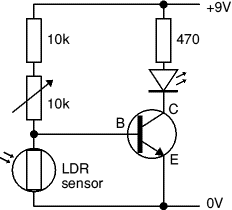Q1. How does the resistance on the LDR change with light illumination on the LDR?
Q2. Why do we need a protection resistor here?
Q3. Why do we always need a protection resistor for LEDs?
Q4. What are the three legs for on the 'Pot'?
Q5. What is the difference between a 10K pot and a 1K pot?
Q6. Why would a 10K pot be better for this LDR than a 1K pot?
Q7. What is a thermistor?
Q8. What is the resistance range of the LDR?
Resistor -
Resistance 560 Ω
Potentiometer -
Ressistance Code 120 Ω
Ressistance - 1k
1) Normal light - 1.56 Ω
light right on top - 0.30 Ω
light very close - 0.56 Ω
short distance - 0.63 Ω
medium distance - 0.99 Ω
long distance - 1.44 Ω
finger over the LDR - 3.25 Ω
2) your using a protection resistor to protect the potentiometer . Because its small like you heat up quickly. and if it has a low ressistance and a high current so it'll blow.
3) to keep the current high so the resisstor doesnt blow. (to keep a high resiance so a low current)
4) there are 3 legs
- the top middle one is input
the bottom 2 (bottom left and bottom right) are both output (ground)
5) one has a bigger maximum resistance
6) to be able to have a bigger maximum resistance
7) A thermistor is a type of resistor whose resistance varies significantly with temperature, more so than in standard resistors.
8) the range is 20 - 20000k Ω

